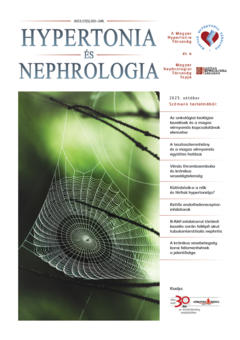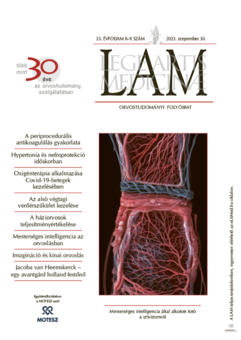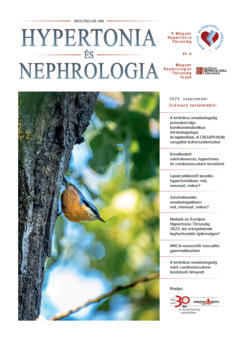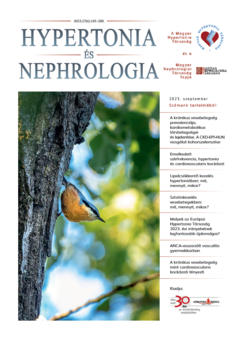The eLitMed.hu medical portal uses computer cookies for convenient operation. Detailed information can be found in the Cookie-policy.
Specialities
Nephrology
[Acute tubulointerstitial nephritis occurring during treatment with a B-RAF inhibitor in a patient with colorectal adenocarcinoma]
[With the expansion of targeted biological treatments in oncology and the improvement in life expectancies, it is increasingly common to consider the long-term and short-term effects of anti-tumor agents on the kidneys, which significantly influence patient mortality and future oncological treatment options. B-RAF inhibitors are widely used, primarily in cases of malignant melanoma and colorectal cancers. We present the case of a young patient with colorectal adenocarcinoma treated with B-RAF (v-Raf murine sarcoma viral oncogene homolog B) and EGFR (epidermal growth factor) inhibitors as second line agents. During treatment, acute renal failure developed, necessitating hemodialysis. Renal biopsy confirmed acute tubulointerstitial nephritis, and we suspected the nephrotoxic effect of the B-RAF inhibitor as the underlying cause. Steroid treatment was initiated, but unfortunately, we lost the patient due to rapid progression of the malignant disease.]
[The importance of early detection of chronic kidney disease]
[The number of patients affected by chronic kidney disease (CKD) is continuously increasing worldwide. It can be present in 1 out of every 10 adults. The prevalence of CKD is over 25% among individuals with diabetes and 26.1% among individuals with hypertension. Unfortunately, due to the late onset of symptoms, the diagnosis of earlier stages of CKD is low. The lack of recognition of stage 3 CKD in patients without comorbidities ranges from 65.0% to 97.1%. In case of comorbidities, the lack of recognition ranges from 47.5% to 94.6%. Screening for CKD, early recognition, and initiating treatment in the early stages can improve kidney function or at least slow down the progression of CKD.]
[Hypertension and nephro-protection in elderly patients]
[The older people’s proportion and life expectancy is gradually increasing in our society, additionally the prevalence of hypertension and impaired kidney function can exceed 60 per cent in this age group. This study aims to highlight the importance of interrelation between hypertension and chronic kidney disease (CKD) and its adequate management, emphasizing professional considerations for the early recognizing and management of CKD, while keeping in mind the specific features of the ageing population in terms of prevention and therapy respectively. The overall mortality risk is higher in patients of advanced age, especially that of the elderly patient with CKD. This can increase their cardiovascular (CV) risk to such an extent that only a small proportion of patients with kidney disease reach the end-stage renal disease (ESRD) status. They die earlier by CV complications before having developed definite ESRD and needed renal replacement therapy. In conclusion, patients suffering from hypertension and CKD have a complex pathogenesis of cardiovascular risks and their CV risk is significantly higher, which requires increased caution and vigilance from the attending physician in the holistic care of elderly patients with kidney disease.]
[Prevalence, Cardiometabolic Comorbidities and Reporting of Chronic Kidney Disease; A Hungarian Cohort Analysis]
[Célkitűzés: A krónikus vesebetegség (CKD) megnövekedett komorbiditási teherrel, rokkantsággal és halálozással társul, így világszerte jelentős népegészségügyi problémát jelent. Magyarországon azonban nem rendelkezünk prevalenciaadatokkal. Módszerek: Vizsgálatunkban a CKD prevalenciáját, stádiummegoszlását és a gyakori társbetegségeket határoztuk meg Magyarországon, a Pécsi Tudományegyetem vonzáskörzetében, Baranya vármegyében élő, egészségügyi szolgáltatást igénybe vevő egyének csoportjában, 2011 és 2019 között, a becsült glomerularis filtrációs ráta (bGFR), az albuminuria és a nemzetközi betegségkódok alapján, adatbázis-elemzés segítségével. Összehasonlítottuk a laboratóriumi mérésekkel igazolt és a releváns diagnóziskódokkal regisztrált CKD-betegek számát. Eredmények: A régióban elő 296 781 egyén közül 31,3%-nál történt bGFR-mérés és 6,4%-nál végeztek albuminuriameghatározást, akik között 13 596 CKD-beteget (14,0%) azonosítottunk a laboratóriumi határértékek alapján. Meghatároztuk a bGFR szerinti stádiummegoszlást (G3a: 70%, G3b: 22%, G4: 6%, G5: 2%). Az összes CKD-beteg 70,2%-a volt hypertoniás, 41,5%-a volt diabeteses, 20,5%-ánál fordult elő szívelégtelenség, 9,4%-ánál szívinfarktus és 10,5%-ánál stroke. A laboratóriumilag igazolt esetek csupán 28,6%-ánál történt meg a CKD diagnózis kódolása a 2011–2019 közötti időszakban. Következtetések: A CKD prevalenciája 14,0% volt az egészségügyi szolgáltatást igénybe vevő lakosok magyarországi szubpopulációjában a 2011–2019 közötti időszakban, emellett a CKD diagnózisának dokumentálását jelentősen alacsonyabbnak találtuk.]
[Statin therapy in kidney patients: what, how much and when?]
[The association between an elevated cholesterol value and the risk of cardiovascular disease is well known. Over decades various classes of drugs were introduced to decrease cholesterol levels, but the real breakthrough came with the use of statins. In the population without renal disease numerous studies have proven statins to be effective in decreasing the level of lipids, in reducing cardiovascular risk, in delaying atherosclerosis and in the regression of plaque. Similarly, in the population with renal disease, many studies have justified the role of statins in reducing CV risk, especially in mild-moderate renal failure, but also in the population of patients requiring dialysis. Studies have also proven their effectiveness in slowing the progression of renal failure and in the reduction of proteinuria. They might also play a protecting role in contrast material-, aminogylcoside-, cardiac- surgery-induced acute kidney injury. Both the cardiac and the renoprotective effectiveness can be explained by summary of their lipid-decreasing and pleiotrop effects. Based on the increased CV risk proven in the population with renal disease, chronic kidney disease is in the high and very-high risk group in national and international guidelines. Reaching the determined lower target values in the high risk and very high risk group is only possible via aggressive antilipemic treatment. Out of statins, molecules capable of intensive decreasing of lipid levels are in favor, in case of ineffectiveness or even from start ezetimib (an agent inhibiting cholesterine uptake) can be added.]
1.
Clinical Neuroscience
Is there any difference in mortality rates of atrial fibrillation detected before or after ischemic stroke?2.
Clinical Neuroscience
Factors influencing the level of stigma in Parkinson’s disease in western Turkey3.
Clinical Neuroscience
[The effects of demographic and clinical factors on the severity of poststroke aphasia]4.
Clinical Neuroscience
Neuropathic pain and mood disorders in earthquake survivors with peripheral nerve injuries5.
Journal of Nursing Theory and Practice
[Correlations of Sarcopenia, Frailty, Falls and Social Isolation – A Literature Review in the Light of Swedish Statistics]1.
2.
3.
4.
5.








